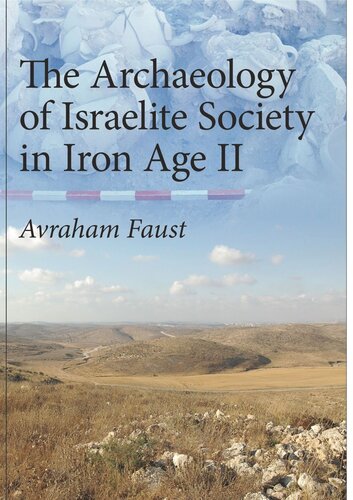

Most ebook files are in PDF format, so you can easily read them using various software such as Foxit Reader or directly on the Google Chrome browser.
Some ebook files are released by publishers in other formats such as .awz, .mobi, .epub, .fb2, etc. You may need to install specific software to read these formats on mobile/PC, such as Calibre.
Please read the tutorial at this link: https://ebookbell.com/faq
We offer FREE conversion to the popular formats you request; however, this may take some time. Therefore, right after payment, please email us, and we will try to provide the service as quickly as possible.
For some exceptional file formats or broken links (if any), please refrain from opening any disputes. Instead, email us first, and we will try to assist within a maximum of 6 hours.
EbookBell Team

4.8
44 reviewsReferring to several important introductory books written about the archaeology of the land of Israel, William Dever once stated: “However adequate these may be as introductions to the basic data, none makes any attempt to organize the data in terms of social structure. . . . This is a serious deficiency in Syro-Palestinian and biblical archaeology, when one considers that the general field of archaeology has been moving toward social archaeology for 20 years or more. (Dever, “Social Structure in Palestine in the Iron Age II Period on the Eve of Destruction,” in The Archaeology of Society in the Holy Land [ed. T. E. Levy, London, 1995, p. 416]).
Lack of discussion of social questions has characterized the archaeology of the land of Israel for some time, even though around the world these questions constitute an important component of archaeological research (see, for instance, the work of Renfrew, Flannery, Gibbon, Blanton, Dark, Bahn, Hodder, Trigger, and many others).
The Archaeology of Israelite Society in Iron Age II fills this gap and analyzes the structure of society in the ancient kingdoms of Israel and Judah from an archaeological viewpoint. It also applies models and theories from the field of social and cognitive archaeology, using the tools of various social-science disciplines (anthropology, sociology, economics, geography, and so on).
Due to his ability to use what is probably the largest archaeological data set in the world—hundreds of planned excavations, thousands of salvage excavations, and extensive surveys, all from the small region that was ancient Israel—Avi Faust contributes not only to the study of ancient Israelite society but to the most fundamental questions about ancient societies. These questions include the identification of socioeconomic stratification in the archaeological record, the study of family and community organization, the significance of pottery, small finds and architecture as indicators of wealth, and more.
This groundbreaking monograph is one of the first attempts at a large-scale study of Israelite society based primarily on the archaeological evidence.
The following acknowledgments were inadvertently omitted from the front matter of the volume:
Amihai Mazar: figure 31
Amnon Ben-Tor: figures 40, 41
Israel Antiquities Authority: figures 21, 24, 25, 26, 29, 30., 32, 33, 36, and Photo 5
Israel Exploration Society: figures 11, 13, 15, 17, 18, 19, 27, 42
Israel Finkelstein: figure 28
Izhak Beit Arieh: figures 34, 35
Shimon Dar: figures 22, 23
The Institute of Archaeology, Tel Aviv University: figures 7, 8
The Institute of Archaeology, the Hebrew University: figures 40, 41
Zeev Herzog: figures 6, 9, 10, 12, 14, 16, 20